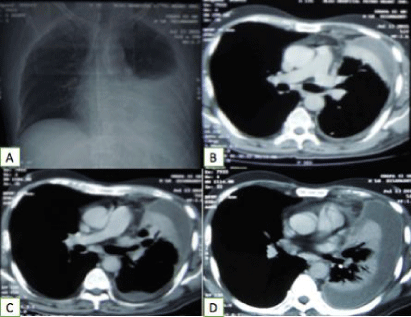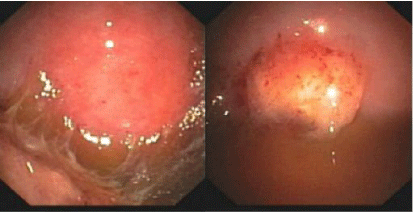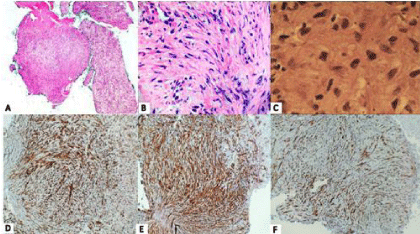
Case Report
Austin J Pulm Respir Med 2015; 2(4): 1035.
Primary Pleural Leiomyosarcoma – A Diagnostic Challenge
Mall S¹, Sharma RK¹*, Talwar D¹ and Dabral C²
¹Metro Centre for Respiratory Diseases, Metro Multispecialty Hospital, India
²Department of Pathology, Metro Multispecialty Hospital, India
*Corresponding author: Sharma RK, Metro Centre for Respiratory Diseases, Metro Multispecialty Hospital, L-94, Sector 11, Noida, UP- 201301, India
Received: November 20, 2015; Accepted: December 16, 2015; Published: December 17, 2015
Abstract
Primary pleural malignancy is uncommon accounting for 0.3-3% of all thoracic tumours. Of these, 90% are malignant mesotheliomas with pleural smooth muscle tumors being exceptionally rare. We present a case of pleural leiomyosarcoma as a second malignancy in a 58 year old ex-smoker who had been previously treated for mucinous adenocarcinoma colon. The pleural tumor presented as acute onset symptomatic left sided pleural effusion and was confirmed by light microscopy and immunohistochemistry of thoracoscopic pleural biopsy. To the best of our knowledge, primary pleural leiomyosarcomas have been described in less than 10 case reports in the past, and this is the first such case of pleural sarcoma involving multiple primary malignancies. This case is being reported to increase awareness about this uncommon clinical entity.
Keywords: Leiomyosarcoma; Pleural malignancy
Abbreviations
MMRC: Modified Medical Research Council scale; GERD: Gastroesophageal Reflux Disease; TLC: Total Leucocyte Count; DLC: Differential Leucocyte Count; LDH: Lactate Dehydrogenase; ADA: Adenosine Deaminase; IHC: Immunohistochemistry; EBUS: Endoscopic Bronchial Ultrasonography; PET: Positron Emission Technique
Introduction
Primary intrathoracic soft tissue tumors are unusual in occurrence, with pleural origin being extremely rare [1]. Leiomyosarcomas are tumors of smooth muscle cells that mainly arise in colon, uterus and retroperitoneal structures. Pleural leiomyosarcomas represent controversial entities with few researchers classifying the diffuse tumors as sarcomatous type of mesothelioma, and more localized ones being considered as variants of solitary fibrous tumors [2]. Clinically it resembles other primary tumors of pleura in symptomatology (chest pain, shortness of breath or cough), physical examination and radiology presenting as pleural effusion or mass lesion. Diagnosis is conclusively made by histological examination supplemented with immunohistochemistry on pleural biopsy specimen and differentiating it from more common pleural malignancies such as sarcomatoid mesotheliomas. Once diagnosed, all other possible sites of origin within the body must be screened and excluded to establish pleura as the primary site. Therefore early diagnosis is often difficult with complete resection of tumor described as appropriate management whenever feasible.
There are few sporadic case reports in literature limiting the knowledge about the etiology or genetics of this rare neoplasm [2-8]. We describe such a case of primary pleural leiomyosarcoma occurring in an elderly patient and present the diagnostic approach along with relevant literature review.
Case Report
A 58 year old male, ex smoker with history of smoking 75 pack years with no significant occupational exposure, presented with acute onset left lower chest painand rapidly progressing dyspnea (from MMRC grade I to grade III) for past 4 weeks. Breathlessness was associated with orthopnea with no history suggestive of paroxysmal nocturnal dyspnea. There was history of intermittent daily fever for 3 weeks along with significant weight loss (6kgs). There was no history of wheeze, hemoptysis, pedal edema, vomiting, diarrhea, joint pain, rash, GERD, or contact with Tuberculosis. Patient had past history of mucinous adeno carcinoma of colon stage 3B (T4N0M0) 8 years back for which he underwent right hemicolectomy with block resection of antrum, gastrojejunostomy & end ileodescending anastomosis. Post surgery patient received 12 cycles of chemotherapy twice weekly (folinic acid, 5-fluorouracil and oxaliplatin) and remained asymptomatic since then.
On presentation, his vitals were PR=102/min, BP= 114/76 mm Hg, RR=30/min and SpO2= 89% on room air. On auscultation, there was decreased air entry on left side of chest. X-ray chest showed opaque left hemithorax with findings suggestive of left pleural effusion (Figure 1). Other investigations revealed haemoglobin=14.2 gm/dl, TLC=7000/cu mm, DLC N76L19E3, platelet 2.2 lacs, and ESR=40mm. Computed Tomography (CT) of chest revealed moderate left side pleural effusion with collapsed underlying lung and pleural thickening involving both visceral and parietal pleura and also involving mediastinal pleura (Figure 1). Diagnostic pleural aspiration showed straw colored fluid with TLC 26,400/cu mm (23% neutrophils and 77% lymphocytes), protein 4.4 gm/dL (pleural fluid to serum protein ratio>0.5), LDH levesl 576 IU/L, ADA levels 14.0 IU/L and no malignant/atypical cells. These findings were consistent with exudative low ADA, lypmphocytic pleural effusion. Pleuroscopy showed few nodular lesions on parietal pleura and fibrinous band all over the pleural cavity (Figure 2). A pleuroscopic guided biopsy was taken and biopsy specimen was sent for histopathology and immunohistochemistry. Histopathology examination showed inflammatory exudates comprising of polymorphs, few lymphocytes and spindle cells arranged in bundles & intersecting at pleura. There was moderate nuclear atypia, myxoid stroma and evidence of tumor necrosis (Figure 3). Immunohistochemistry (IHC) showed strongly positive tumor cells for vimentin, desmin and smooth muscle actin (Figure 3). These cells were immunonegative for all other markers including cytokeratin, calretinin, CD 68, CD117 and KI67 (25%), ruling out carcinoma and sarcomatous mesothelioma. An EBUS examination of mediastinal lymph nodes revealed reactive lymphoid tissue. A whole body PET scan showed pleural enhancement with mediastinal lymphadenopathy and no other primary site in body. Hence a final diagnosis of primary pleural leiomyosarcoma was made on basis of microscopic and IHC results. Patient was offered chemotherapy but he declined and left against medical advice deciding to go for alternative treatment.

Figure 1: A. X-ray chest showing homogenous opacity with concavity upwards
at the left lower zone obliterating the left costophrenic angle suggestive of
left pleural effusion B. C. D. Computed Tomography (CT) of chest showing
moderate left side pleural effusion with collapsed underlying lung and pleural
thickening involving visceral, parietal pleura and mediastinal pleura.

Figure 2: Pleuroscopy showing A. Fibrinous band all over the pleural cavity
and B. Nodular lesions on parietal pleura.

Figure 3: A. Biopsy showing spindle cell tumor with extensive necrosis B.
Biopsy showing neoplastic spindle cell proliferation arranged in interlacing
fascicles C. H&E section showing cigar shaped spindle cell nuclei with
atypical mitosis and pleomorphism D. Immunohistochemistry showing
vimentin positivity E. Desmin positivity F. Smooth muscle actin positivity.
Discussion
Leiomyosarcomas are cancers of smooth muscles commonly arising from urogenital tract, gastrointestinat tract, and rarely in respiratory tract. Serosal smooth muscle malignancies are even more unusual [3]. Till date, only ten cases of primary pleural leiomyosarcomas have been reported in the literature to the best of our knowledge [2-8]. Most of these presented as asymptomatic patients with mass lesion discovered incidentally on chest X-ray. Others had history of chest pain and progressive dyspnea with or without signs of pleural effusion. Most common presentation of leiomyosarcoma is pleural effusion or thickening and our patient had both the features on radiology.
Clinically pleural leiomyosarcoma is difficult to suspect as there is no specific etiological factor and it closely resembles other primary pleural malignancy in clinical, physical and radiologic attributes [9]. Malignant mesothelioma is the most common differential with the sarcomatous type having even similar histopathological picture [4,9]. Other possible differentials for primary pleuralneoplasms include solitary fibrous tumor, malignant fibrous histiocytoma, synovial sarcomas and thymomas. Most pleural tumors are metastatic from other extrathoracic sites in body. So exclusion of metastatic leiomyosarcoma is an essential step in diagnosing the primary lesion. Our patient underwent FDG PET scan and no primary was found in any other part of the body thus confirming the diagnosis as a primary tumor.
Microscopically leiomyosarcomas are characterized by malignant spindle cells with cigar shaped nuclei and scant fibrillary cytoplasm [3,4]. However pathological diagnosis is difficult due to clinical and histological similarities with sarcomatous mesotheliomas. Therefore use of IHC staining for antibody panel is recommended in order to confirm the diagnosis. Leiomyosarcoma is uniformly positive for smooth muscle actin, desmin & vimentin and negative for calretinin, carcinoembryonic antigen, cytokeratin, CD117 and S100 protein [4,9].
Due to rarity of this entity, not much knowledge is available regarding the cytogenetics of this tumor. Few studies have revealed contained chromosomal losses at 10q and 13q, which are the most common losses described in soft tissue leiomyosarcomas [10]. The pleural tumor in our patient was preceded by a colonic adenocarcinoma. The presence of multiple primary malignancy in elderly patients with high grade soft tissue sarcomas has also been documented in a study by Kozawa et al. with incidence as high as 21% [11]. Though we were unable to do cytogenetic study in our patient, a possible genetic correlation between the two primary can be considered.
Optimal treatment for pleural leiomyosarcomas is not well defined. Surgery is considered optimal for limited disease, if resection is feasible. In literature most common treatment is surgery alone or with neoadjuvant radiotherapy [4,5,9]. For tumors of other side, unresectable tumors or metastasis, chemotherapy is common as treatment of choice with success rate of around 20% and median survival 12 months. Our case refused for any treatment and was sent home on palliative therapy.
Conclusion
Due to rarity and close resemblance with other pleural tumors, primary leiomyosarcomas is confirmed on basis of histological examination supplemented with immunohistochemical staining, after ruling out metastasis from other body sites. This case further adds to literature about the clinicopathologic profile and diagnosis of this rare entity and raises awareness of considering it as a differential for pleural mass lesion.
References
- Moran CA, Suster S, Perino G, Kaneko M, Koss MN. Malignant smooth muscle tumors presenting as mediastinal soft tissue masses. A clinicopathologic study of 10 cases. Cancer. 1994; 74: 2251-2260.
- Gibbs AR. Smooth muscle tumours of the pleura. Histopathology. 1995; 27: 295-296.
- Moran CA, Suster S, Koss MN. Smooth muscle tumors presenting as pleural neoplasms. Histopathology. 1995; 27: 227–234.
- Al-Daraji WI, Salman WD, Nakhuda Y, Zaman F, Eyden B. Primary smooth muscle tumor of the pleura: a clinicopathological case report with ultrastructural observations and a review of the literature. Ultrastruct Pathol. 2005; 29: 389-398.
- Proca DM, Ross P Jr, Pratt J, Frankel WL. Smooth muscle tumor of the pleura. A case report and review of the literature. Arch Pathol Lab Med. 2000; 124: 1688-1692.
- Mizunoe S, Kawano H, Morinaga R, Uenishi Y, Hiramatsu K, Yamasaki T, et al. A case of primary pleural leiomyosarcoma. Nihon Kokyuki Gakkai Zasshi. 2001; 39: 770-774.
- Rais G, Raissouni S, Mouzount H, Aitelhaj M, Khoyaali S, El Omrani F, et al. Primary pleural leiomyosarcoma with rapid progression and fatal outcome: a case report. J Med Case Rep. 2012; 6: 101.
- Ozyurtkan MO, Akin M. Primary pleural leiomyosarcoma presenting as multiple pleural masses. Turk Gogus Kalp Dama. 2015; 23: 762-765.
- Knuuttila A, Jee KJ, Taskinen E, Wolff H, Knuutila S, Anttila S. Spindle cell tumours of the pleura: a clinical, histological and comparative genomic hybridization analysis of 14 cases. Virchows Arch. 2006; 448: 135-141.
- El-Rifai W, Sarlomo-Rikala M, Knuutila S, Miettinen M. DNA copy number changes in development and progression in leiomyosarcomas of soft tissues. Am J Pathol. 1998; 153: 985-990.
- Kozawa E, Sugiura H, Tsukushi S, Urakawa H, Arai E, Futamura N, et al. Multiple primary malignancies in elderly patients with high-grade soft tissue sarcoma. Int J Clin Oncol. 2014; 19: 384-390.